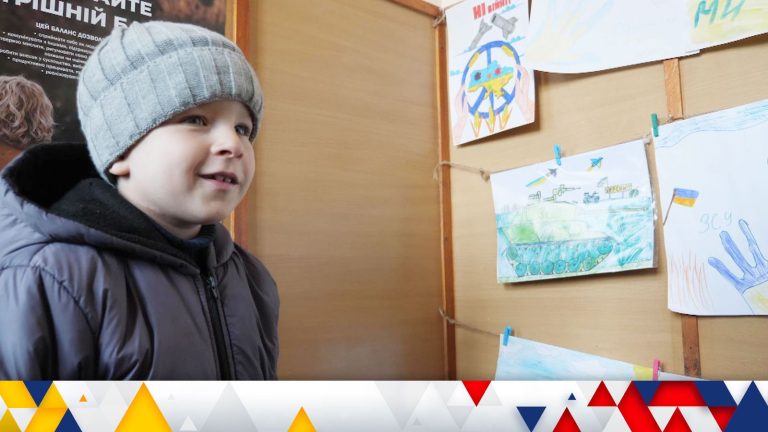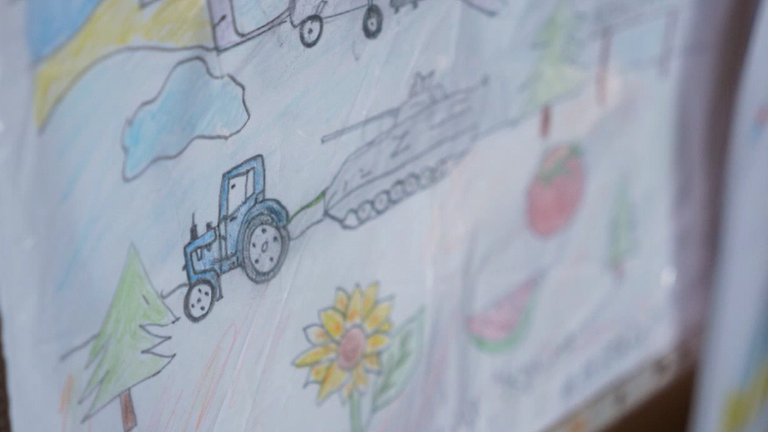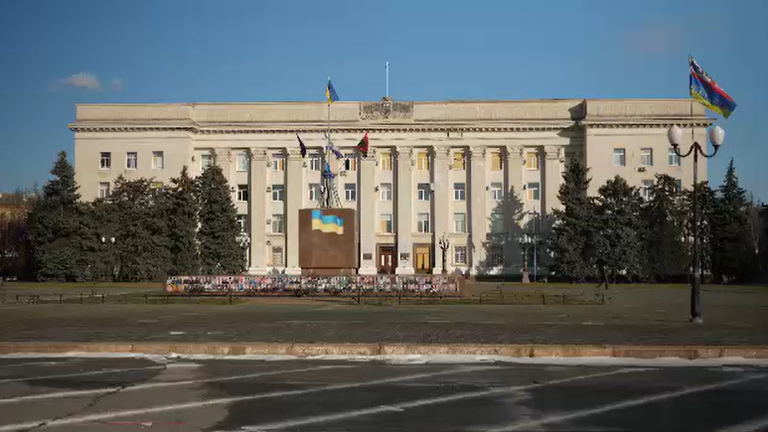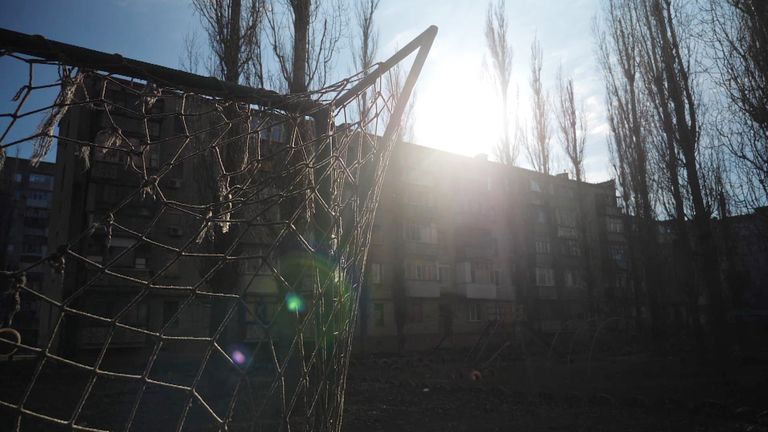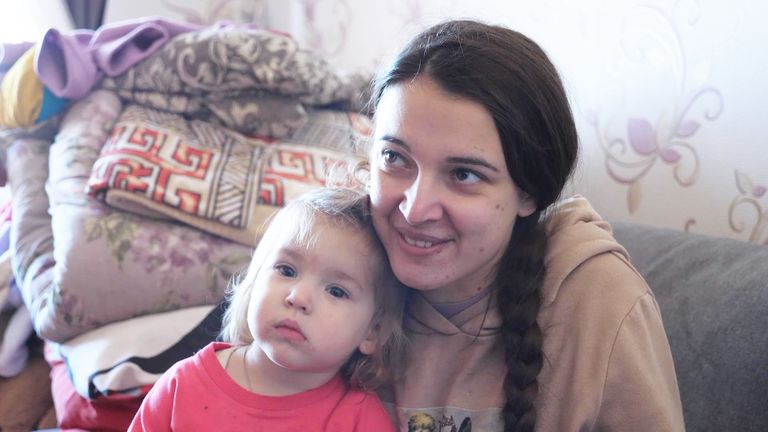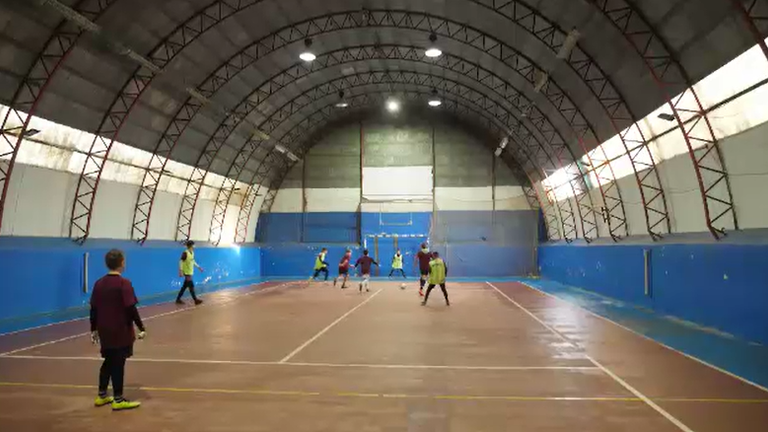Invading Russian forces drown in a river in the front-line city of Kherson, while a Ukrainian soldier watches with his rifle raised.
The picture, drawn by a child, is among a group of pictures, including planes, tanks, and corpses Ukraine She lost her childhood after nearly two years of total war.
It hangs on a wall inside a school – closed for regular lessons – where a charity is providing support to the dwindling number of children in Kherson whose parents have not yet fled.
A six-year-old boy, looking at the drawings, says his favorite is a large Ukrainian tank.
The last war in Ukraine: the plane was “shot down in a terrorist act”
“I love tanks,” says Ivan Rozsoha, holding the hand of his grandmother, who brought him to school for speech therapy.
It's scary when that happens, says the little boy, wearing a puffy winter coat and wool hat Russian Troops launch artillery, drone and missile attacks on his city – a daily occurrence.
“When the rockets fall, I try to hide my head under my toys,” Ivan says, gesturing with his hands.
He wants to be a soldier when he grows up and believes Russia is bad, saying: “They are destroying Ukraine and I know how to destroy them.”
His grandmother, Zeina Ruzsoha, 67, looks sad when she hears such heavy thoughts from a child. When asked how she felt, she only said: “Tears.”
Speech therapy takes place in a classroom with more than a dozen other children, ages four to seven, sitting at tables, holding crayons and colored pencils.
Therapist Anastasia Andryushenko encourages them to express themselves through art, by drawing sad and happy faces, and then explains why they choose these expressions.
She says that an increasing number of children in Kherson have difficulty speaking. Some no longer speak at all, terrified by the fighting, and have little opportunity to communicate with others.
“The war affected them profoundly in terms of their mental health,” says the therapist.
She adds: “In the last lesson, we were drawing Christmas trees with the children.
“Everyone had to draw a Christmas tree from their imagination. Many children drew a Christmas tree with explosions and grenades. There was even a nuclear Christmas tree, which the soldiers were defending.”
Loss of innocence
This loss of innocence is not surprising given everything Ukraine's children have been exposed to since Russia launched its massive invasion on February 24, 2022.
Russian forces occupied the city of Kherson in southern Ukraine since the first days of the war. Ukrainian forces were able to expel them after just over eight months.
However, efforts to push deeper into Russian-controlled territory have faltered, and the front line remains on the eastern side of the Dnipro River that marks the southern tip of the city.
Air-raid sirens and artillery are the soundtrack for the few thousand children still living in Kherson – their parents unwilling or unable to leave.
Schools and nurseries are closed, so all lessons take place online at home – when there is electricity and an internet connection.
In a small one-story house on an unassuming residential street, six-year-old Eva Lychenko plays alone with her dollhouse in her bedroom — playing outside is too dangerous.
The blonde-haired girl with a shy smile does not like online learning and rarely has the opportunity to socialize with other children.
“She no longer has a childhood,” says her mother, Emma Lychenko, 37. “They just took it away from her.”
Read more from Sky News:
At least 18 people were killed in Russian air strikes
Ukraine claims two high-value Russian planes were 'shot down'.
At night, Yeva is often kept awake by explosions.
The mother says: “When the sound is very loud, I always come to her and say: Don’t be afraid, Mama is with you.”
“I try not to show that I'm worried or nervous, but inside I'm just praying.”
The mother says she does not want to move far, partly because of the cost but also because there is no guarantee that other cities will be completely safe.
She adds: “I tell myself all the time: Just a little longer and victory will be achieved.”
Rare access to the most dangerous part of Kherson
Sky News was granted rare access to an island located between the banks of the Dnipro River.
It is actually a dividing line between Ukrainian and Russian forces, although some Ukrainian forces have managed to cross to the east bank amid heavy fighting.
The island is the most dangerous part of Kherson. However, some families with young children still live here as well.
We approach some dreary-looking concrete apartment buildings surrounding an empty playground of rusty climbing frames and hammocks in a residential section of the island.
On the ninth floor of a building, a young couple lives with their two young daughters, Varvara, two years old, and Arina, only 18 months old.
Their apartment is small, filled with blankets and pillows to keep the family warm when the power goes out—and it has just returned when we meet them after a three-week outage following an attack on a local power facility.
The temperature outside is freezing.
The mother, Anastasia Tatarinova, who appears to be in her early twenties, says life is difficult and the threat posed by Russian forces is increasing.
“There are very huge explosions,” she says, sitting on the sofa, cradling her youngest child on her lap.
“Yesterday there was a drone flying over us. It's really worrying. We feel nervous all the time.”
She was pregnant with Arina when the all-out invasion began. The little girl, her hair tied in a small ponytail on top of her head, had known nothing but war.
“I heard an explosion in my stomach, so I never saw a normal life,” Tatarinova says.
“We are afraid to play on the field, so we stay at home. It is very dangerous outside because bombing happens all the time.”
When asked if the family would leave if the situation worsened, she said: “If it continues like this, of course, why do we stay here? We will have no other choice.”
Click to subscribe to Ukrainian War Diaries wherever you get your podcasts
Football is 'too important' to give up
Despite the danger, some children in downtown Kherson still cling to one passion: football.
The boys take aim at a target inside a well-used gym in a curved-roof metal barn, nestled between apartment buildings and abandoned market stalls.
The coach blows a whistle as the kids race and kick soccer balls.
Sitting in the changing room with his sports socks on, 12-year-old Rostislav Semenyuk says his dream is “to become a second Lionel Messi.”
He would also like to become a politician when he grows up.
The boy says he barely remembers what life was like before the war.
When asked if he could think of anything he missed, he said: “More matches – football matches. There are fewer matches now.”
The head football coach says his boys and girls – the girls are scheduled to train the next day – will not be able to play matches in the Kherson region because it is too risky.
Instead, they travel to areas far from the front line to face other teams.
The opportunity to train is “very important,” says Viacheslav Rolle.
“The children are suffering from war so they need to be distracted,” says the coach.
“The only opportunity they have to communicate with each other is in our training.”
Another boy, wearing a maroon uniform, says football is his life.
“I like training,” says 12-year-old Kirilo Tsivelsky, pausing briefly to chat.
“My dream is for my friends to come back, for the war to end, and for all these Russians not to survive.”

